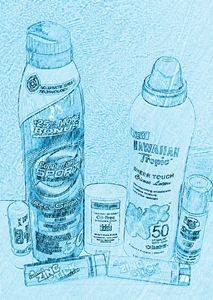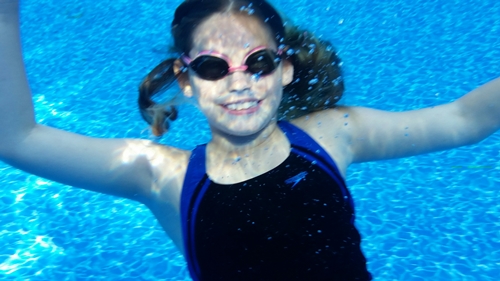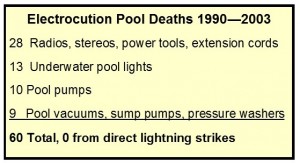Summertime has arrived! Here are some fun, serious and what some might think are absurd questions about water safety. Take the quiz and test your knowledge.
True or False?
- You should wait half hour after eating before you can safely go swimming.
- Sunburn will fade into a tan.
- Clear pool water means clean pool water.
- Most children under the age of one who drown, drown in backyard pools.
- Drowning is noisy. I’ll hear my child splashing and struggling in time to help.
- As long as a child is wearing a swim diaper or rubber pants, there’s less of a chance for contamination of the water.
- Infant/toddler swim lessons prevent drowning.
- You can get “swimmers ear” without going swimming.
- Just for fun: Hiding underwater can stop a person from being hit by bullets.
- The cost of a near drowning will be covered by your insurance.
- Indoor pools should be cleared during electrical storms.
- Males and females drown at the same rate in the U.S.
- If you go outside with wet hair, you’ll catch a cold.
- You only need to shower before going into the pool if you haven’t bathed all day.
- I’m not a great swimmer, nor will I ever be. I am a sinker not a floater.
- When I get red eyes while swimming, it means there is too much chlorine in the water.
- Sunscreen with SPF 30 has twice the protection of SPF 15 lotion.
- A child can become afraid of the water after learning to swim.
- Dunking is the best way to teach your child to swim.
How'd you do?
1. Wait a half hour after eating before you can safely go swimming. False
- This myth is universally accepted and still believed today.
- This myth involves the possibility of suffering severe muscle cramps and drowning from swimming on a full stomach.
- It is true that the digestive process does divert the circulation of the blood toward the gut, and to a certain extent, away from the muscles.- so naturally you wouldn’t want to swim after eating a big meal, thanksgiving dinner….but a peanut butter and jelly is probably fine.
- There has never been a documented case of drowning caused by swimming on a full stomach.
- As with any exercise swimming right after a big meal might be uncomfortable, but it won’t cause you to drown.
- This myth was started by moms who needed a break from watching their kids swim.
2. Sunburn will fade into a tan...or better yet, some folks think you need to burn first before you can start to tan. False 
- Sunburn is a burn and not a prerequisite stage for a tan.
- Sunburn will result in skin damage, redness, and peeling.
- Any amount of sun exposure poses an increased risk for the development of skin cancers and premature aging, but sunburn poses an even stronger risk.
3. Clear pool water means clean pool water. False
- Microorganisms can be present even in pools that appear clean.
- What you smell, feel and hear can help you sense whether you’re swimming in a healthy pool.
4. Most children under the age of one who drown, drown in backyard pools. False
- Children under the age of one mostly drown in bathtubs, buckets and toilets.
- During 1996-1999, 58 kids less than 5 years old drown in buckets. (CPSC)
5. Drowning is noisy. I’ll hear my child splashing and struggling in time to help? False
- Maybe in the movies…but not in real life- this myth really endangers young children.
- Children may not know what to do to right themselves or stand up, even in a few inches of water - as a result, they just “slip away” in silence.
- “Sinkers” - “Plunge Downers” are drowning victims who never resurface and slip under water quietly.
6. As long as a child is wearing a swim diaper or rubber pants, there’s less of a chance for contamination of the water. True and False
- “Accidents” from diapered children pose a risk of contamination from fecal matter. To minimize this risk, make sure your child's bottom is clean and don’t swim if you or your child have loose stools.
- Make sure a clean, form-fitting “swim diaper” is worn by the child at all times. At the same time, keep in mind, swim diapers are not leak proof!
7. Infant/Toddler swim lessons prevent drowning. False
- Four – six years of age is the best age to learn.
- Infant and toddler swim lessons can have serious drawbacks; ENT problems, swallowing water, and overconfidence.
- There is no evidence to support infant/toddler lessons for drowning prevention.(American Academy of Pediatrics)
8. You can get “swimmers ear” without going swimming. True
- Pseudomonas is a rod shaped bacteria found in aqueous environment that causes a variety of infections.
- Those living in hot and humid locales often contract “Swimmers Ear”, an infection of the external ear canal.
- Use alcohol or vinegar in a glycerin solution for prevention.
9. Just for fun! Hiding underwater can stop a person from being hit by bullets. True
- Partially confirmed.
- All supersonic bullets (up to .50-caliber) disintegrated in less than 3 feet (90 cm) of water.
- Slower velocity bullets, like pistol rounds, need up to 8 feet (2.4 meters) of water to slow to non-lethal speeds.
- Shotgun slugs require even more depth (the exact depth couldn't be determined because their one test broke the rig).
- As most water-bound shots are fired from an angle, less actual depth is needed to create the necessary separation.
Mythbusters Episode 34 July 13, 2005
10. The cost of a near drowning will be covered by your insurance. DEPENDS
- Healthcare cost for each near drowning event range from $75,000 for emergency room services to $180,000 per year for long term care.
- Brain damage as a result of near drowning can cost up to $4.5 million.
- Annual cost of care per year in a chronic care facility for an impaired survivor of a near drowning event is approximately $100,000. (CDC, American Academy of Pediatrics)
11. Indoor pools should be cleared during electrical storms. False
- Since 1990, there have been 60 electrocution deaths plus 50 serious shocks in or around pools due to faulty equipment. (CPSC, 2003)
- No electrocution deaths are due to lightning have ever been recorded at indoor pools.
- US Swimming and NCAA DO NOT address lightning and indoor pools.
As a safety precaution, the SAS Natatorium policy regarding electrical storms is to close the pool at the sight of lightning or sound of thunder for 30 minutes.
12. Males and females drown at the same rate in the U.S. False
- The CDC reports that 80% of all drowning deaths in the US occur to males. (2003)
- Ironically, men of all ages, races and backgrounds consistently report greater swimming ability than women!
13. If you go outside with wet hair, you’ll catch a cold. False
- Cold weather, wet hair, and chills don't cause colds.
- Viruses cause colds. People tend to catch colds more often in the winter because these viruses are spread more easily indoors, where there may be more contact with dry air and people with colds.
- Dry air - indoors or out - can lower a person's resistance to infection.
14. You only need to shower before going into the pool if you haven’t bathed all day. False
- All swimmers should shower before entering the pool. Perspiration, body oil, perfume, urine, and other waste are with us at all times and are rinsed off in the shower (or in the pool water should you skip your pre-swim shower.)
- It is a state law to shower before entering a public pool.
- In addition, showering before entering the pool allows your hair and skin to absorb more fresh water and helps reduce the risk of your hair and skin from drying out due to the chlorine in the water. This is especially pertinent for those with sensitive skin or color treated hair.
15. I’m not a great swimmer, nor will I ever be. I am a sinker not a floater. False
- I love this one!!!! This bit of philosophy tends to be used more an excuse to not put in the time to adapt to the aquatic environment and learn to work with the water.
- Having worked with numerous swimmers and athletes who struggle with this concept, one thought always comes to mind….RELAX!
- The majority of good swimmers are “sinkers” due to their low body fat percentage.
16. When I get red eyes while swimming, it means there is too much chlorine in the water. False
- Red eyes and itchy skin are usually caused by improper pH or high chloramine levels. Surprisingly, the pool may actually need additional chlorine treatment to get rid of chloramines and sanitize the water.
17. Sunscreen with SPF 30 has twice the protection of SPF 15 lotion. False
- SPF 15 lotion blocks 93 percent of the harmful rays.
- SPF 30 lotion blocks 97 percent of the harmful rays.
- As long as your SPF is in the 15-30 range, you’re safe.
- Most experts today, agree that an SPF above 30 provides very little additional protection- It’s a marketing gimmick.
18. A child can become afraid of the water after learning to swim. True
- Just because your child had no fear and is a good swimmer one summer (or day), doesn’t mean he will feel the same way the next summer(next day, in a week, or a month.) This is especially true with younger children ages 0-4 if they are not regularly exposed to swimming.
- Keep your children in the water regularly to reinforce being comfortable in and around the water.
19. Dunking is the best way to teach your child to swim. False
- There are different schools of thought on dunking small children under water-excessive water swallowing, choking and gagging are not part of learning to swim.
- Limit the number of times you submerge your child (no more than 3 times is a good rule of thumb) even if they do it on their own (on accident).
If you have any questions about water safety or these quiz questions, post your questions below. Thank you for taking the time to take this quiz! I hope you learned some valuable information! Happy and safe swimming!



